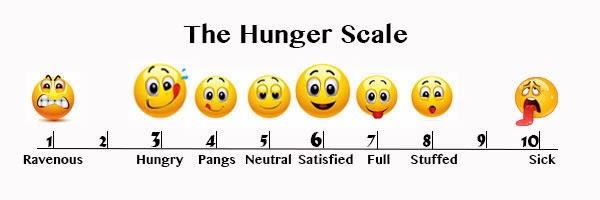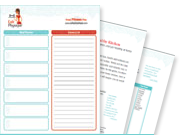Do you eat on a schedule, according to certain environmental cues, or when you’re actually hungry? If you find yourself frequently eating for reasons other than physical hunger, you’ve likely identified a culprit in your weight loss or weight maintenance frustrations.
If your body’s hunger cues have been silenced over the years, use this rule of thumb to help you get back on the normal hunger track: Go no longer than 4 waking hours without eating, then assess your hunger level. Your liver’s energy tank runs out of “gas” in about 3-6 hours, so most women begin to feel the biological signals of hunger during this time frame – depending on what they last ate, of course.
The hunger scale is a way to describe your level of hunger. By describing it you become more conscious and better able to assess your hunger and need for food. You can lose weight, and never gain it back, if you usually eat only when you’re physically hungry (a 3 on the hunger scale) and only eat until you are satisfied (6 on the hunger scale). If you often eat until you are uncomfortably stuffed you will gain weight, especially when your physical activity is limited.
 0 – So hungry that you’re not even hungry – You know what I’m talking about, don’t you?
0 – So hungry that you’re not even hungry – You know what I’m talking about, don’t you?
1 – Headache, shaky, too hungry to care what or how much you eat – you WILL overeat
2 – Losing concentration, grumpy–seriously hungry – your stomach is empty, you must eat now
3 – “I’m hungry” – stomach growling
4 – Not hungry but not satisfied
5 – Neutral
6 – Satisfied, comfortable, not hungry, full
7 – In slight discomfort, you feel the food
8 – Uncomfortable – sleepy, sluggish, you want to change into looser clothes
9 – Overly stuffed. “I ate too much. I am stuffed.” – very uncomfortable, stomach hurts
10 – In pain. Thanksgiving Dinner – take a nap
Assess you level of fullness…Just as it’s important to know when to eat, it’s equally as important to listen when your body signals that you’re no longer hungry. Observe the signs that show you’re comfortably full – not stuffed.
One of the keys to intuitive eating is being able to eat when you’re hungry, continue eating until you are satisfied, and not take a bite more. This definitely sounds easier than it is when you first start, but practice over time (along with a little support from our dietitians and wellness coaches), will make this second nature. In the meantime, try pausing when you’re halfway through your meal to check on your current fullness level, and stop eating when you get to a level 5 or 6.


